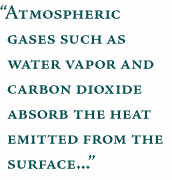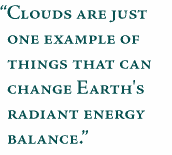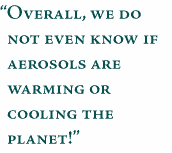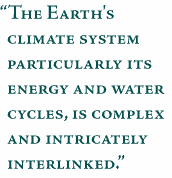
 |
||
|
|
||
|
Most of the Sun's heat is deposited into the tropics of the Earth. This is because the Earth's rotational axis is almost perpendicular to the plane of Earth's orbit around the Sun. The polar latitudes receive on average much less solar heating than the equator. If the tilt of the Earth's axis were exactly perpendicular to the orbit plane around the Sun, then there would be no seasons! Climate in January would be the same as climate in April or July, all over the Earth. But the Earth's rotational axis tilts 23.5 degrees away from perpendicular. Consequently, during one part of the orbit around the Sun, the North Pole will be tilted 23.5 degrees toward the Sun and will be in Sunlight 24 hours a day. Six months later at the opposite side of the orbit around the Sun, the North Pole will be in total darkness 24 hours a day. Why is this important? The amount of solar heating of the polar latitudes varies greatly through the year. In the summer, polar latitudes receive almost as much solar energy as the tropics, while in the winter they receive no solar heat at all. Meanwhile, the tropics receive by comparison roughly constant solar heating throughout the year (hence the small seasonal cycles there). As a result, in the winter hemisphere, the difference in solar heating between the equator and the pole is very large—a situation perfect for driving a strong "heat engine," or circulation of the atmosphere. This energy difference drives large mid-latitude storm systems as heat moves from the surplus in the equator to the deficit in the polar regions. In contrast, the summer has very similar heating at the equator and poles, such that the heat engine slows down, and mid-latitude storms lose their source of energy. Summer storms tend to be very small scale and local. Solar heating of the Earth and its atmosphere drives the large-scale atmospheric circulation patterns, and even the seasons. The difference in solar heating between day and night also drives the strong diurnal (or daily) cycle of surface temperature over land. But with all this solar heating going on, we still haven't answered our earlier question: Why doesn't the Earth just keep getting hotter? The answer might be loosely called the yang and yin, or the "duality of radiation fluxes." At the same time the solar energy that we can see with our eyes is heating the planet, there is radiation being emitted at much longer wavelengths that our eyes do not see—called "thermal infrared radiation" (basically heat). The amount of heat emitted from a solid surface is proportional to the fourth power of the temperature of the surface. So as the temperature of the Earth rises, it rapidly emits and loses to space an increasing amount of heat. If the Earth were a ball of rock with no atmosphere, a simple calculation that equates the solar energy absorbed by the Earth to the heat emitted by the Earth would predict the global average Earth temperature to be 0 degrees Fahrenheit, or 255 Kelvin-very cold, and not the Earth as we know it (this scenario assumes that an average rock reflects 30 percent of all light that hits it).
Atmospheric gases such as water vapor and carbon dioxide absorb the heat emitted from the surface, capturing it in the atmosphere (Figure 1). Because atmospheric temperature decreases with altitude, the heat emission of the atmosphere is at a much lower temperature than the surface. So the Earth and atmosphere keep heating up until the heat emitted roughly balances with the amount of sunlight absorbed. This trapping of heat by carbon dioxide and water vapor is typically called the "greenhouse effect," and these gases are referred to as "greenhouse gases." It is the increase in these gases with time (led by carbon dioxide release from burning oil, gas, and coal) that leads to the potential for future climate change. In fact, most theoretical models predict that as temperatures in the atmosphere increase, the amount of water vapor will increase, thereby acting as a "positive feedback" loop to further increase atmospheric temperatures. |

|
|
Clouds: A hot topic or are we made in the shade?
Given the large impact of clouds on the radiative energy balance, the critical question now becomes: What effect will clouds have on surface temperatures if global climate changes in the next century? No one knows. Clouds could act to dampen any greenhouse gas warming by increasing cloud cover, increasing thickness, or by decreasing in altitude. Conversely, clouds could act to increase warming of the planet if the opposite trends occur. In fact, the climate is so sensitive to how clouds might change, that our current best models of global climate can vary in their global warming predictions by more than a factor of three depending on how we try to model the clouds. So why can't we model clouds? The biggest problem is that clouds are almost explosive in nature when compared to the rest of the climate system. Cumulus clouds can form in seconds to minutes, and the entire life cycle of a massive thunderstorm can be measured in hours. This thunderstorm cloud may only cover 20 to 50 miles of the Earth's surface, while our best global climate models on the world's fastest supercomputers can only track a single column of the surface and atmosphere every 50 to 200 miles.
back: Introduction |

|
|
Surface Absorption and Reflection
Less obvious, but still important, when vegetation is cleared from land surfaces (such as in deforestation or agricultural burning), the bare surface reflects more sunlight back to space and there is net cooling effect. But, there is also counter productive greenhouse gas effect that comes from deforestation and biomass burning—the release of carbon dioxide, as well as elimination of vegetation that would otherwise absorb carbon dioxide from the atmosphere during photosynthesis. Unfortunately, while deforestation/reforestation may take place on annual to decadal time scales, the lifetime of carbon dioxide in the atmosphere is 50 to more than 100 years. Consequently, the solar reflectance cooling and greenhouse gas warming due to biomass burning take place at very different time scales, leading to an initial cooling followed later by a warming trend.
back: Clouds: A hot topic or are we made in the shade? |

|
|
Atmospheric Aerosols: Fossil Fuel and Biomass Burning
As the number of aerosols increases, the water in the cloud gets spread over many more particles, each of which is correspondingly smaller. Smaller particles fall more slowly in the atmosphere, and decrease the amount of rainfall. In this way, changing aerosols in the atmosphere can change the frequency of cloud occurrence, cloud thickness, and rainfall amounts. Even the tiny aerosols (typically less than 50 millionths of an inch or 1 micron across) can affect the clouds, which in turn can change the radiation balance of the planet. Thus, aerosols can have both a direct effect on the energy balance, as well as an indirect effect (through clouds). It is thought that the indirect effect of aerosols can be even larger than their direct effect, but at present it is not known whether such an effect is a net cooling or warming of the planet.
back: Surface Absorption and Reflection |

|
|
From measurements to climate models
Ultimately, we are searching for a set of mathematical models that allow us to span the incredibly large range of space and time scales important to aerosols, water vapor, clouds, the land surface, and the oceans. These models must be capable of reproducing the variability shown in the data at both regional and global scales. They must be capable of reproducing El Niño, the Earth's diurnal and seasonal cycles, and the inter-annual variability in the climate system. The models must also be capable of reproducing the systematic changes in the radiative energy balance with changing aerosols, water vapor, clouds, and surface properties. Only then can we begin to trust the models to produce accurate global change predictions. It should be noted that these are not the only tests such models must successfully pass, but they are a critical part of the story. Water and carbon cycles in the climate system are also critical. Moreover, the development, testing, and improvement of such models using global data sets will be an iterative process, with no assurance of success. The process will be a continual narrowing of the uncertainties. The Earth's climate system, particularly its energy and water cycles, is complex and intricately interlinked. The discovery of these links, and the development of improved predictive computer models using these links, is at the heart of NASA's Earth Observing System (EOS) observations and science plan. back: Atmospheric Aerosols: Fossil Fuels and Biomass Burning |

|
|
Subscribe to the Earth Observatory About the Earth Observatory Contact Us Privacy Policy and Important Notices Responsible NASA Official: Lorraine A. Remer Webmaster: Goran Halusa We're a part of the Science Mission Directorate |